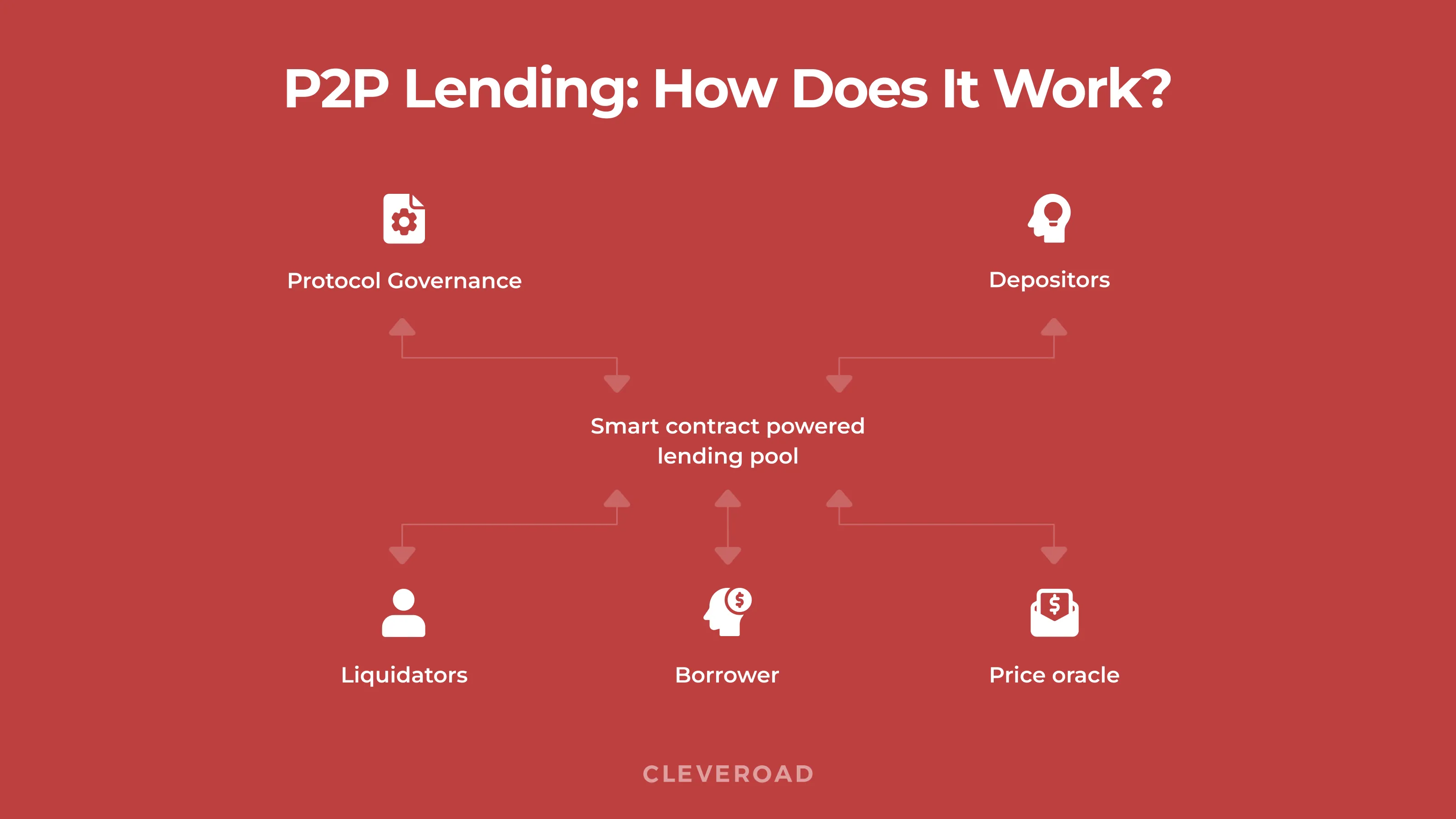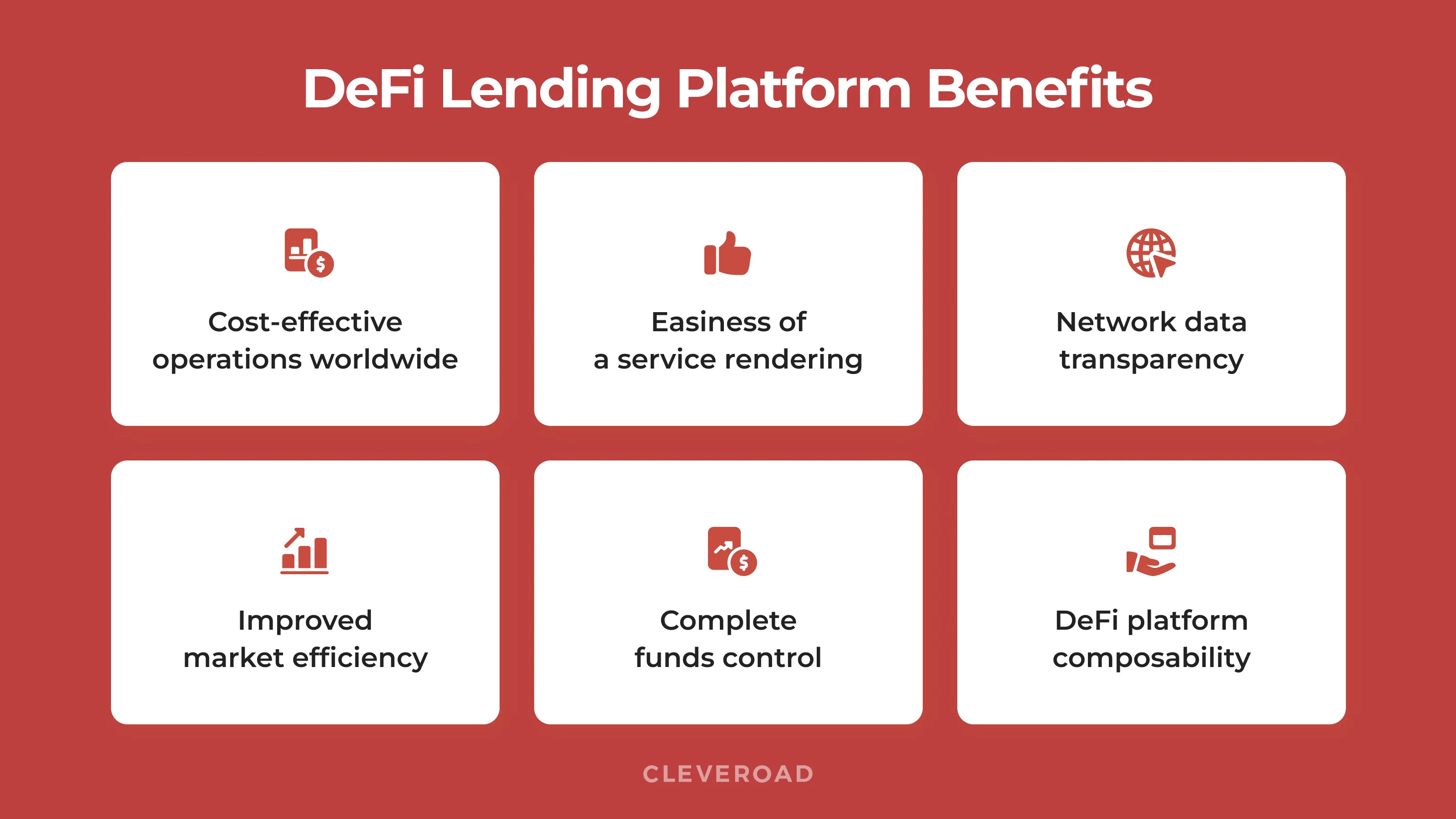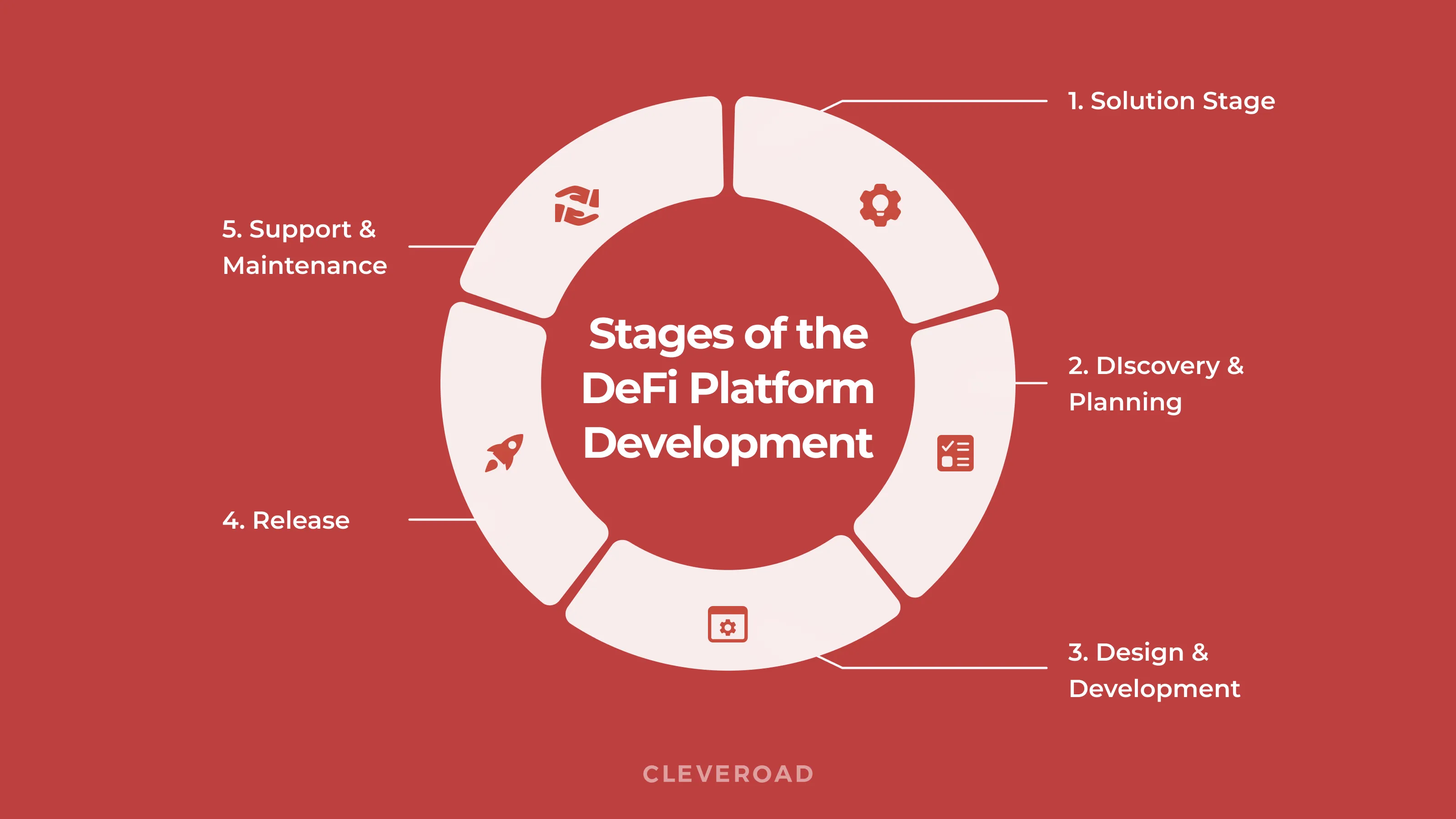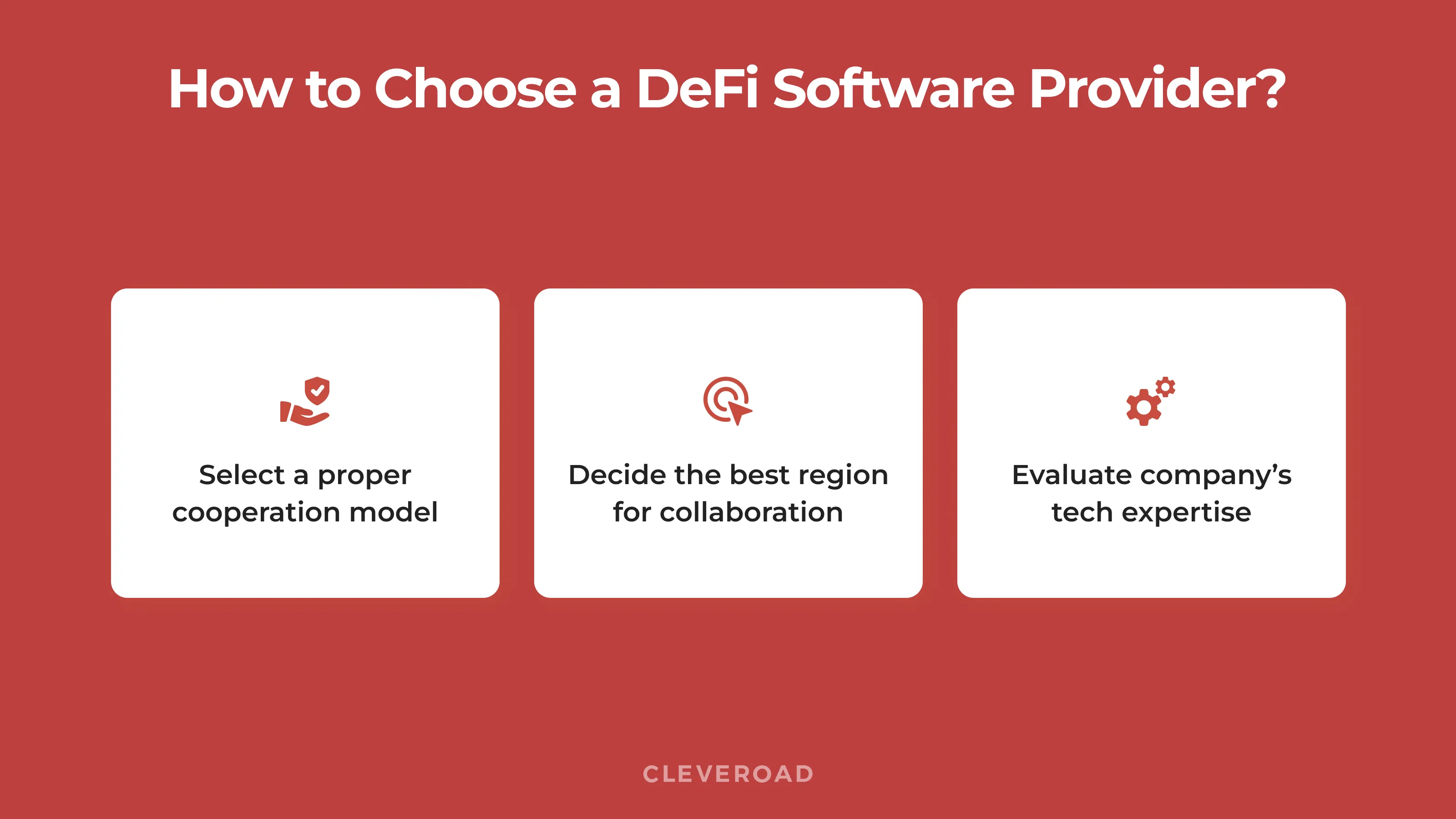DeFi Lending Platform Development Guide: Essentials, Building Process, and More
Updated 26 Aug 2023
19 Min
1638 Views
The interest in Blockchain is growing among experts of different business domains, especially Fintech ones. Such an interest results in more innovative software solutions appearing on the market. Moreover, prominent lending models like peer-to-peer (P2P) payments are enriched with new features.
We’ll talk more about P2P payments and DeFi systems as a way to transfer them. Furthermore, you will find out the advantages of DeFi lending and borrowing platform development, the creation stages you should pass through, and many other essentials.
Working Model of DeFi Lending
The lending process has been existing since the birth of money relationships. From those times, two traditional types of loans, such as collective and investment property one, turned into a peer-to-peer (P2P) lending model.

P2P lending: how does it work?
One of the P2P distinctive features is that it allows borrowers and lenders to collaborate through an online P2P platform instead of applying to banking establishments as traditional mediators in such relationships. As a result, both parties receive their benefits. Borrowers can quickly access the required funds without banking bureaucracy and investors have simple access to direct funding with better terms and a higher interest rate.
The Internet has significantly changed the scope and possibilities of P2P lending relationships: lending companies have got an opportunity to create online marketplaces that can serve as mediators during borrowers' and lenders' collaboration. The transaction is based on the borrowers' credit histories as well as the underlying assets (if any) that support the loan.
Blockchain technology has put significant adjustments into the fintech sphere. Thus, the developers can use Blockchain to solve the problems concerning the existing banking systems, and DeFi lending platform development is one of the efficient solutions of such type. Rafael Cosman characterizes this new notion as follows:
Rafael Cosman
CEO and co-founder of TrustToken
Decentralized finance is an unbundling of traditional finance. <...> DeFi takes the key elements of the work done by banks, exchanges, and insurers today—like lending, borrowing, and trading—and puts it in the hands of regular people.
So let's deeper research this term.
The DeFi lending and borrowing platform development means creating a system equipped with a set of financial tools helpful for users to access funds without the necessity to collaborate with banks, exchanges, or brokerages. All the activities, such as lending/borrowing, cryptocurrency trading, interests earned in saving-like accounts, etc., will be performed with the help of the Blockchain-based smart contracts. One of the most distinctive features of DeFi is that it’s free from centralized management, which typically controls transactions made.
Learn how to create an NFT marketplace using DeFi and blockchain smart contracts
These systems function as follows:
- Launching the process, the borrower puts up the crypto assets as a security.
- The platform offers loans based on automated smart contracts use.
- The borrowers have a distinct interest rate to pay, and the lenders receive that interest.
Working on the basis of the DeFi lending protocols, such platforms simplify the P2P cooperation between their users. Moreover, the DeFi platform benefits borrowers and lenders: the first ones can get a loan as usual, and lenders can earn money by giving crypto asset loans in collateral. DeFi also offers high interest rates for long-term investors.
Furthermore, the Decentralized Finance platforms are easy to use: everybody can become a borrower, having signed up and linked their digital wallets to start using a platform. That’s why its popularity grows, as well as its market, which reached $159.24 million, according to TheNewsCrypto. So, the DeFi lending/borrowing platform development is in demand now, and we’ll find out why.
Who Can Benefit From DeFi Lending and Borrowing Platform Development
DeFi borrowing platform development is a powerful tool to change the future of the fintech industry. The financial services are rendered in digital form — more secure, entirely open, transparent and accessible. Decentralized finance lending enables borrowers to obtain assets without the use of mediators. A lender can use a decentralized platform to stake their coins, and a borrower can take out a loan directly.
Let's talk more about the most common benefits from DeFi use.

DeFi lending platform benefits
Cost-effective operations worldwide. Due to the absence of intermediaries, DeFi offers to users minimal or no operational costs for the services rendered, as well as the beneficial currency exchange. Such an advantage can be widespread around the world since the DeFi protocols and platforms are dispersed among the worldwide available blockchains.
Easiness of a service rendering. Blockchain allows every user to securely operate funds without a third-party institutions' assistance. It is available thanks to the decentralization principle, which gives a simplified access to financial services for everybody, democratizing the fintech industry.
Network data transparency. The DeFi system data is opened for public monitoring; so, the information about the Blockchain network activity is accessible for everybody. DeFi solutions also use cryptographic algorithms to authenticate the validity of data before it is recorded. Such transparency can demonstrate that a company operates honestly, attracting additional investors.
Improved market efficiency. Operating with DeFi crypto assets makes lending and borrowing automatic. It can cut costs, speed up financial flows and increase the option number.
Complete funds control. Users have ultimate control over their earnings and how it is used. For instance, DEXs and DeFi trading platforms allow you to trade whenever you want and choose your own partners for trading. Centralized platforms, on the other hand, require you to deposit your assets before trading and trust the exchange to keep them safe.
DeFi system composability. The DeFi apps and protocols can exchange data without a signup required. Due to that, the DeFi solutions can be assembled like LEGO details. That's why they are sometimes called Money LEGO.
Decentralized financial platforms help users gain total control over their funds and transparently manage them without any effort. We will walk you through how to create a DeFi app, covering key development steps, essential features, and best practices for building a secure and efficient platform.
Features That DeFi Platform Should Support
Planning the decentralized finance platform development, one of the first things you should do is to create a feature list for an upcoming platform. We’ll talk more about the basic features you should include to your perfect DeFi solution with the help of DeFi lending/borrowing platform development services.
The decentralization is the main concept of a new Web 3.0 development. Check our recent guide to learn more!
Borrowing and lending are necessary to compensate for the collateral ratio, cryptocurrency assets as well as demand and supply ratio. Keep in mind that lending and borrowing operations are the very things customers would join your platform, so you have to duly care about their proper functioning.
Flash loans let customers pay back loans, take it out with no collateral to manage smart contract-automated transactions or execute arbitrage transactions.
Rate switching feature enables switching between stable and variable interest rates protecting borrowers from sudden market fluctuations.
Margin trading feature is required for traders that entails trading with borrowed money. This allows for raising profit in low-volatility markets or in the short run.
DeFi wallets should be provided for proper depositing of customers’ assets. You need to have several ones or a branded crypto wallet possessing additional value for DeFi system users. Moreover, it should support a variety of tokens and stable coins.
Fiat gateway feature enables users to exchange fiat money for traditional crypto (usually called fiat currencies, while others are called non-fiat ones). Moreover it gives an opportunity for newbies to start their activity on platform regardless even with no cryptocurrency assets.
Smart contract ensures full decentralization of the DeFi system. It acts as an automated digital mediator, handling the flow of funds, transactions, and calculations carried out on the platform.
Liquidity Pool includes funds deposited by lenders. It guarantees that your platform posseses sufficient funds available to be borrowed.
Investment rewards feature aims to encourage lenders to submit funds for borrowing on your platform as well as to retain lenders for long-term success.
Governance should be provided to users for getting rights to vote on future system’s upgrades.
User dashboard should be reinforced with self-explanatory and seamless controls for convenient user administration.
You can also care about liquidity pools implementation and security features realization and ask a DeFi lending/borrowing platform development company to include them in the solution’s functionality. Advanced features that can be provided may include yield swaps, credit delegation, staking and so on.
The enlisted functionality is included into the basis of well-known DeFi platforms, and we’ll tell you about some of them.
SushiSwap
SushiSwap allows customers to trade, earn, stack yields, lend, borrow, etc. Users can move between chains with a single click thanks to a multi-chain automated market maker. The key advantage of SushiSwap is the support of a wide range of blockchain-based cryptos.
TraderJoe
This DeFi platform lets customers lend crypto assets and trade them, join numerous mining pools and earn a high APR, farm liquidity with multiple assets, and much more. People can try out TraderJoe right immediately by connecting through a browser wallet such as MetaMask and trading assets on the Avalanche C-chain.
PancakeSwap
PancakeSwap's success over other platforms is because of its inexpensive prices and a large number of trading pairs. It allows customers to trade a variety of assets, farm liquidity, participate in mining pools, and has just launched an NFT platform. This DeFi solution uses the BNB blockchain to provide lightning-fast transactions with minimal fees.
Check our latest article to find out the NFT marketplace development cost
How to Build a DeFi Lending Platform
Regarding the increase of the DeFi lending platforms’ popularity among the fintech institutions, there are a lot of entrepreneurs that want to develop such a platform for their business. We’ll tell you about the typical DeFi crypto lending platform development. The typical Cleveroad software creation lifecycle is given as an example for more clear understanding of the subject.
After a first contact, brief aim discussion and protecting your app idea by Non-Disclosure Agreement (NDA) signing, it’s a high time to pass through outlining the solution on high-level. At Cleveroad, we call this stage a Solution Stage and it's free for our customers.

Stages of the DeFi platform development
Solution Stage
After getting your request, we contact you, answer the initial questions, outline the core aims and the business context, and schedule a meeting with the Solution Team. It’s required to detail your project requirements. Then, your request and introductory information are processed by the Solution Design team. It includes business analysts (BAs), a solution architect (SA), and a designer (if necessary). The dedicated team determines:
- Business goals
- A work scope
- Main constraints & concerns
- Basic quality attributes
Based on the analyzed data, we prepare a rough software development estimate, team composition, timeline, and form a proposal. The stage takes approximately 2 weeks.
Discovery Phase
The purpose of our discovery phase is to decompose and detalize your requirements, like DeFi protocols and functionality to include, third-party services to integrate, and platforms to use — web preferred. You should also think about rates and fees for the future platform and what Blockchain to choose. If you doubt, the experts can consult you due to these questions and help you choose the required technology frameworks or prioritize functionality as to ROI expectations.
Moreover, our professionals research project requirements, complete required paperwork, mitigate any hazards, and arrange meetings to address business goals and user/tech requirements. They also review the list and advise which features to remove or keep to launch faster — but the final decision is yours.
At this stage, our team also prepares a rough estimation, the team composition for the project, and writes a specification. Our designers create visual concepts and design the main page (if it's a web product) in different styles, colors, and wireframes. You revise them and pick the most appropriate version.
Design and Development
This stage implies creating a DeFi lending platform under approved requirements. Creating your own platform means developing a backend and frontend of the product using an appropriate tech stack, including API integration. The development process is divided into sprints (2-week periods), during which a team of software engineers needs to perform an intended part of project work. Each of the sprints starts with planning a work scope and ends with delivering a working item of a product or functionality. To avoid prolonged development, it’s better to start with MVP development. This approach will allow you to test the waters and build software with minimal investments.
QA engineers conducts multiple tests to ensure the platform work as expected. The team examines the functionality generated during each sprint and works on a project until it is released. They test both the backend and the frontend and then provide reports for software engineers to use in bug fixing. After the completion of the sprints, they also conduct regression and stress testing to understand how the system would perform under high stress.
The developers should also care about DeFi protocols implementation predefined earlier on the discovery stage. It can be the following ones:
- Aave is a well-known open-source lending protocol that has switched from the DeFi P2P lending concept. Customers can borrow money without a collateral lock for a limited period, alter rates, and take advantage of a variety of other benefits.
- Dharma is a DeFi lending protocol enabling users to perform borrowing or lending DAI or USDC at different interest rates.
- Compound is an open source DeFi protocol allowing users to earn interest and borrow assets against collateral on the Ethereum network. You don't need to verify your identity using Compound; moreover, you can give or borrow money without a restriction.
Wonder how the software development process goes at Cleveroad? Read our article know this flow's peculiarities!
Release
The team is ready to deploy the product after regression testing and resolving all QA concerns. Developers must create hotfixes if serious issues are discovered.
On the day of the release, we move the web project to the live server or, if it is an app, we assist with its publishing on marketplaces. When you're satisfied, the team gives you the project materials, such as:
- Source Code
- Software Architecture Document (SAD)
- Features breakdown list
- Software specification (detailed requirements)
- Design files
- All other project documents and artifacts that were created all long the project
Support and Maintenance Phase
Our collaboration does not end after your DeFi platform is released. We may keep working on it to make numerous modifications based on user input and maintain your solution with new features and upgrades. It is gained with the help of error correction, code optimization, and other operations.
We described a typical DeFi project workflow; however, you should understand that you need to find a competent software development provider to make a DeFi platform development seamless and obtain a profitable end product.
Delve into the development flow required to build a decentralized exchange in our post
Choosing a Vendor For DeFi Lending/Borrowing Platform Development Services
Collaboration with a skilled software development vendor knowing all the ins and outs of the Blockchain technology implementation into your software will be beneficial for your project development. Keep in mind that finding a partner for productive DeFi lending and borrowing development services will be easier if you stick to the points described below.

How to choose a DeFi lending platform development provider?
Select A Proper Cooperation Model
Looking for a software provider, the client should understand how to build the future relationships with the tech partner. IT cooperation models are the very things to establish communication between client and vendor.
We explain the most common cooperation models typically offered by Cleveroad.
Time & Material
IT professionals can estimate the scope of a project and start working without being acquainted with the actual workload. The main idea of the Time & Material contract is that Cleveroad’s team takes responsibility entirely on our side: we control the delivery process, the budget consumption, the scope of implementation and change requests management, the overall product quality, etc. The team works almost autonomously and rarely involves you when required. It goes on iteratively, from sprint to sprint, and:
- The demo is prepared, tested and sent to customers along with checklists, sprint reports and other documents.
- Customers look through the documents and give feedback.
- The specialists analyze the obtained feedback and discuss it while planning the next sprint. Moreover, they prepare a list of changes needed by clients, document them and make time estimations each modification would take.
Change requests sent during the current sprint are addressed to the next one. A work bill is submitted only for the DeFi borrowing platform development we've completed.
The distinctive features of Time and Material cooperation model:
- It’s especially cost-efficient for large projects with changing needs.
- Each sprint is planned transparently, being discussed with the client in detail.
- The T&M workload is flexible: you can easily manage the work scope of your team.
Dedicated Team
A dedicated team approach is a good option for complex and large projects. You may simply scale up your internal departments with more employees, or put up an agile team for a new project or software update. The vendor company in turn, will provide you with a substantial technical competence, a large pool of skilled personnel, and a non-disclosure agreement (NDA) signing per your request.
However, keep in mind that the provider assists only in organizational issues; and you have to control the DeFi borrowing platform development process and its administration.
Why pick a Dedicated Team Collaboration:
- Get total control over dedicated team developers, workflows, and well-established communication protocols with complete transparency.
- A specialized team may be scaled up and down as needed and incorporated into current development procedures.
- It's simple to distribute resources, and obtain essential technical competence at a low cost.
Don’t know yet how to use a Dedicated Teams model to your advantage? Our guide will give you a hint!
Decide What Region is the Best For Cooperation
App development cost is one of the most disturbing issues for entrepreneurs when they need software creation for their business. If the in-house team's services are too expensive to pay for, the companies may pay attention to outsourcing cooperation. Country choice is essential to make this cooperation a long-term one.
Below we’ll list the main criteria you should consider selecting an outsourcing region.
Differences in culture and language with your future partner will be a serious obstacle if you won't do serious homework. First off, especially considering offshore outsourcing, you need to make sure whether the personnel properly speaks English, writes, and understands it.
Moreover, the cultural issue should also be precisely investigated. The customs and traditions of each region are unique, so you should deeply research the habits and lifestyle to avoid any unpleasantries. Bear in mind that you should also care about understanding each other on a business level.
Hour zones should be highly appreciated while selecting an offshore destination. If your hour zone differs from your partner's one for a few hours, it typically won't be a problem. However, such a difference would be a problem if it isn't overlapped: for instance, if you are from Estonia, and plan to work with a tech partner in China, the time difference is 6 hours. It means they end their working day while you're just starting it. For example, Cleveroad specialists can accommodate time differences. We form a communication plan with clients to hold meetings at a convenient time for clients.
A pool of tech talents is a significant benefit outsourcing gives to clients. Such benefit becomes available as some countries graduate top-quality IT specialists with perfect hard skills due to the exceptional education. However, you should remember that the perfect specialists you should look for must have a combination of hard and soft skills (e.g., flexibility).
The Cleveroad team regularly participates in multiple conferences and meetings devoted to the latest updates in FinTech to enrich its expertise. Our experts apply new approaches and technologies in projects to introduce innovations to advance our customers’ business needs. Additionally, our senior specialists have certifications in approaches for collaboration: IIBA, CSPO, A-CSPO, PSM, PSPO, PMI, etc., to help you select the best-suited tech solutions to achieve the project’s business goals.
Low pricing may draw your attention to certain geographic places, but this should not be the deciding element in your selection. Instead, consider service quality to be the most critical component in any outsourcing success formula, and make no concessions on it. Make sure you choose a service partner with in-depth expertise in financial development services that tends to balance cost and excellent software quality.
Finding a proper outsourcing destination while looking for a DeFi lending/borrowing platform development company is a question of a successful and productive cooperation that will fulfill your business needs. Don’t think you’ll gain your purpose having conducted a brief online research of the outsourcing region. Apart from the above defined points, your research should contain the country's economic situation, IT infrastructure or legislation.
Evaluate Their Expertise
If your objective is to produce a robust and durable software that achieves desired results, you realize that your IT partner's technical competence is critical. But such a check would be difficult if you’re a non-tech person. This way, you can consult with your developers (if you need to augment your team with an expert) or hire an independent tech consultant to evaluate developers' experience. Remember that IT outsourcing companies already have a pool of validated specialists required to fulfill complex projects, such as DeFi lending platform development.
Consider industry expertise
Pay attention to the company’s expertise to ensure you receive the desired product. The IT partner should have practical experience in Blockchain and Fintech. The industry expertise accelerates the building of fintech products since the team is familiar with processes, necessary tools and technologies, and challenges they may face. Furthermore, don't hesitate to look through their corporate blog to know more about their technological base.
Pay attention to their questions
An ideal partner will be involved and even brave enough to question your judgment and ideas - all in the project's best interests. The chosen staff must be able to see issues before they get too serious, offer helpful advice, and suggest alternate options.
Ask them in turn
You can also interrogate them in the interview to know more about their activity (especially the DeFi lending/borrowing platform development). We’ve prepared a list of the common questions that can be offered to your potential tech partner:
- How deep is your tech experience?
- What is the size of your team? What kind of specialists do you have onboard?
- Are you capable of delivering a product over the whole development cycle?
- How likely are you to advise a friend or partner about your business?
- How does information travel throughout your company? Do you leverage mentoring?
The IT outsourcing model offers all these points to your attention. You can find a reflection of all the described criteria in it, and develop a project profitably for your business.
DeFi Borrowing and Lending Platform Development Services From the Domain Experts
Borrowing and lending DeFi platform development is quite a complex and challenging task requiring a skilled vendor’s assistance. Cleveroad is the appropriate one, and we’ll tell you why right now.
This professional software development service provider, headquartered in Estonia, offers IT products for online payments simplification, financial analytics collection, as well as secure banking solutions and legal compliance. Being for 10+ years on the market, we have been providing our clients with mobile solutions for established businesses, and turnkey digital products.
Working with us, you will get:
- DeFi lending and borrowing platform development services to create a top-class Fintech product perfectly fitting your business and meeting your company requirements and needs
- Fast project development flow with no bureaucracy
- In-depth consultations with our Solution Architect, Business Analysts, Project Managers or other required professionals
- A team of agile-oriented and certified specialists that will completely meet your project requirements and easily integrate into the current workflows
- Accurate input requirements collection to correctly identify a workload from early stages
- Qualitative support, maintenance and ads services after release for our customers, etc.
We are ready to bring into life your app concepts that will facilitate your business flows, and take your company to the new level. If you've got questions, don’t hesitate to contact us for a comprehensive consultation, which may be a start of a productive collaboration.
Build your own DeFi platform now
Get a full-fleged financial software development services to create a DeFi system meeting your needs
The DeFi is a system that’s equipped with a set of financial tools helpful for users to access funds without the necessity to collaborate with banks, exchanges or brokerages. All the activities, such as lending/borrowing, cryptocurrency trading, interests earning in saving-like accounts, etc., will be performed with the help of the Blockchain-based smart contracts. One of the most distinctive features of DeFi is that it’s free from centralized management, which typically controls transactions made.
- Cost-effective operations worldwide
- Easiness of a service rendering
- Network data transparency
- Improved market efficiency
- Complete funds control
- DeFi system composability
- Select a proper cooperation model
- Decide the best region for collaboration
- Evaluate company’s tech expertise

Evgeniy Altynpara is a CTO and member of the Forbes Councils’ community of tech professionals. He is an expert in software development and technological entrepreneurship and has 10+years of experience in digital transformation consulting in Healthcare, FinTech, Supply Chain and Logistics
Give us your impressions about this article
Give us your impressions about this article
